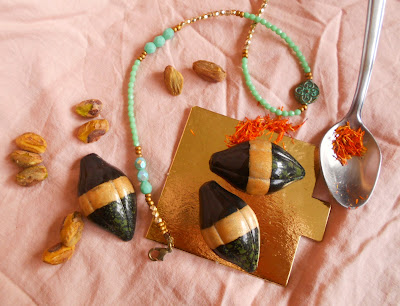Krokos spártai ifjú Hermész szeretője volt, ám egyszer diszkoszvetés közben az isten véletlenül megsebesítette őt. Krokos földre hulló véréből született meg a sáfrányvirág, amelynek három vörös bibéjét a vércseppjei színezték meg.
A virág később Éosz, a hajnal istennőjének szimbólumává vált: Ovidius Sáfrány Anyaként hivatkozott rá, más szerzők aranyszínű szandáljáról, tiarájáról és sáfránnyal színezett rózsás ujjairól írtak, amelyekkel megnyitja a mennyet, hogy a Nap felkelhessen. Homérosz szólt sáfránnyal kivarrt köpenyéről, amelyet védelmezőn a földre terít. A sáfrányhoz hasonlóan az Éoszról szóló történetek is hangsúlyozzák érzékiségét és bujaságát.
A sáfrány szülőhazája valószínűleg Irán, Mezopotámia vagy Görögország - íze valóban karakteres: egyszerre édes és pikáns; számomra leginkább a Közel-Kelet ízvilágát idézi fel. Épp emiatt nehezebb csokiban elképzelni. Sokat gondolkodtam, hogy mivel párosíthatnám, végül a neten bóklászva találtam eladó pisztáciás-sáfrányos bonbonokat - recept persze nem volt mellé, de sebaj, megalkottam a sajátomat :)
Hozzávalók:
70 gr étcsoki
fél kiskanál sáfrány
40 ml tejszín
egy kiskanál vaj
150 gr pisztácia
porcukor
pisztáciaolaj
200 gr tejcsoki
ételfesték
Elkészítés:
A tejszínhez keverem a sáfrányt és felmelegítem. Én benne hagytam a sáfránydarabkákat, de le is lehet szűrni. Hozzáadom a vajat, és az olvasztott étcsokit, majd simára keverem. Félreteszem.
A pisztáciát meghámozom, robotgépbe teszem két kiskanál porcukorral és igény szerinti mennyiségű pisztáciaolajjal, majd addig darálom, amíg egységes masszát kapok.
Levágok megfelelő méretű darabokat az öntapadó papírszalagból és beragasztom őket a forma mélyedéseibe. Felállítom a formát és mohazölddel fröcskölöm össze a mélyedések alsó felét. Az esetleg félrecseppent festéket vattával törlöm ki a mélyedések másik feléből. Ezután feketével festem ki a mélyedéseket. Végül kiszedem a papírszalagot, a helyén maradt csíkokat arannyal festem át.
Temperálom a tejcsokit, elkészítem a bonbonok burkát. Egy réteg pisztáciapasztával, majd egy réteg sáfrányos ganache-sal töltöm meg őket, végül temperált tejcsokival lezárom.
Épp emiatt nehezebb csokiban elképzelni. Sokat gondolkodtam, hogy mivel párosíthatnám, végül a neten bóklászva találtam eladó pisztáciás-sáfrányos bonbonokat - recept persze nem volt mellé, de sebaj, megalkottam a sajátomat :)
Krokos, a Spartan youth was Hermes' lover; however, once the god accidentally wounded him while throwing a discus. From his blood pouring on the ground was born the crocus (saffron) flower whose three red styles were colored by his blood.
Later on, the flower became Eos' symbol. The goddess of dawn was called the Saffron Mother by Ovid; other authors described her golden sandals, tiara and saffron-dyed fingers which open the heavens for the Sun to rise. Homer wrote about her saffron-embroidered robe which she spreads on the Earth for protection. Just like saffron is considered an aphrodisiac, the stories about Eos emphasize her sensuality.
The saffron originates from Iran, Mesopotamia or Greece - its flavor is characteristic: sweet and spicy at the same time; it reminds me mostly of Middle Eastern culinary. Therefore it is not easy to imagine it with chocolate. I was brainstorming for a while what kind of flavor I should pair it up with, and finally while browsing the internet, I came across pistachio-saffron bonbons. Of course, the recipe wasn't included, so I made up my own :)
Ingredients:
70 gr dark chocolate
half spoonful saffron
40 ml cream
one small spoon of butter
150 gr pistachio
icing sugar
pistachio oil
200 gr milk chocolate
food paint
Recipe:
I add the saffron to the cream and warm it up. I left the saffron pieces in it but you can also sieve it. I add the butter and the melted dark chocolate and stir it to get a smooth cream.
I clean the pistachios and put them in a blender together with two small spoonful of icing sugar and pistachio oil. I blend it until I get a thick paste.
I cut off some stripes of the self-adhesive paper band and stick them into the cavities of the mold. I hold the mold in an upright position and sprinkle moss green paint into the lower half of the cavities. I clean the upper halves with cotton. Then I paint the cavities with black paint. Finally, I get rid of the paper bands and paint the middle of the cavities with gold.
I temper the milk chocolate; I prepare the bonbon shells. I fill them with one layer of pistachio paste and a layer of the saffron ganache. Finally, I seal the bonbons with tempered milk chocolate.






No comments:
Post a Comment